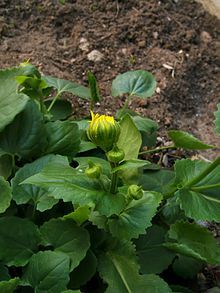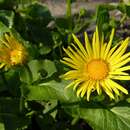Comments
(
Inglês
)
fornecido por eFloras
Doronicum orientale appears not to have persisted in British Columbia or Newfoundland.
- licença
- cc-by-nc-sa-3.0
- direitos autorais
- Missouri Botanical Garden, 4344 Shaw Boulevard, St. Louis, MO, 63110 USA
Description
(
Inglês
)
fornecido por eFloras
Plants 12–60(–90) cm. Stems sparsely pubescent proximally, glabrate distally. Leaves: blades of basal leaves ovate-orbiculate, (3–)6–14 × 3–6.5(–8.5) cm, bases cordate, margins crenate to subentire, faces (and petioles) sparsely hairy; cauline leaves 1–2(–3), sessile, blades ovate to lanceolate, bases clasping. Heads borne singly, 25–68 mm diam. Peduncles 45–150 mm. Phyllaries linear-lanceolate, 8–14(–18) mm, lengths about 1 / 2 rays, apices acute. Ray corollas 12–28 mm. 2n = 60.
- licença
- cc-by-nc-sa-3.0
- direitos autorais
- Missouri Botanical Garden, 4344 Shaw Boulevard, St. Louis, MO, 63110 USA
Synonym
(
Inglês
)
fornecido por eFloras
Doronicum caucasicum M. Bieberstein
- licença
- cc-by-nc-sa-3.0
- direitos autorais
- Missouri Botanical Garden, 4344 Shaw Boulevard, St. Louis, MO, 63110 USA
Doronicum orientale
(
Inglês
)
fornecido por wikipedia EN
Doronicum orientale, the leopard's bane, is a European plant species in the family Asteraceae.
Description
Doronicum orientale is a perennial herb that has daisy-like yellow flower heads on long, straight stems, which attract nectar-eating insects. The plants grow to approximately 2 feet (60 cm) tall. The basal foliage is bright green with cordate leaves that have scalloped margins. Its native habitats include moist, rocky outcrops and woodland areas.[2]
Etymology
The specific epithet "orientale," means "eastern" and is in reference to its native range of eastern Europe,[2] not eastern Asia.
Distribution
It is native to southeastern Europe (Italy, Greece, the Balkans, Hungary, Moldova, Ukraine, southern European Russia)[3][4] and parts of southwest Asia (Turkey, South Caucasus).[5][6]
Cultivation
Doronicum orientale is widely cultivated as an ornamental.[7] There are a few reports of the species having escaped cultivation and been found growing wild in parts of Canada, but the plant apparently failed to become established there.[8] D. orientale is a hardy (to zone 3) perennial, blooming in early spring. It likes both shade and sun and is easily grown in moist, fertile soil. The plant attracts butterflies.[2] Cultivars include 'Little Leo', which is semi-double.
Toxicity
All parts of this plant are poisonous to humans.[9]
References
-
^ The Plant List, Doronicum orientale Hoffm.
-
^ a b c "Doronicum orientale 'Leonardo Compact' - Plant Finder". www.missouribotanicalgarden.org. Retrieved 2021-11-08.
-
^ Altervista Flora Italiana, Doronico orientale, Kaukasus-Gämswurz, gemsrot, Doronicum orientale Hoffm. includes photos and European distribution map
-
^ Plantarium, Doronicum orientale Hoffm. Описание таксона, Русскоязычные названия, Дороникум восточный Archived 2015-07-18 at the Wayback Machine in Russian with photos and partial distribution map
-
^ Royal Horticultural Society, Doronicum orientale, Caucasian leopard's bane
-
^ Karadeniz A, Çinbilgel I, Gün SŞ, Çetin A (2015). "Antioxidant activity of some Turkish medicinal plants". Nat Prod Res. 29 (24): 2308–12. doi:10.1080/14786419.2015.1005618. PMID 25649168. S2CID 42327987.
-
^ Naturegate, Leopard's Bane, Doronicum orientale
-
^ Flora of North America, Oriental leopard’s-bane, Doronicum orientale Hoffmann, Commentat. Soc. Phys.-Med. Univ. Lit. Caes. Mosq. 1: 8. 1808.
-
^ Pink, A. (2004). Gardening for the Million. Project Gutenberg Literary Archive Foundation.

- licença
- cc-by-sa-3.0
- direitos autorais
- Wikipedia authors and editors
Doronicum orientale: Brief Summary
(
Inglês
)
fornecido por wikipedia EN

Emerging flower buds
Doronicum orientale, the leopard's bane, is a European plant species in the family Asteraceae.
- licença
- cc-by-sa-3.0
- direitos autorais
- Wikipedia authors and editors


 Emerging flower buds
Emerging flower buds